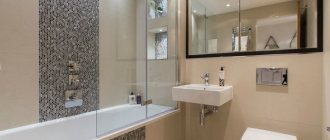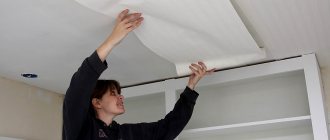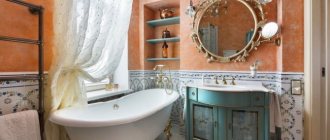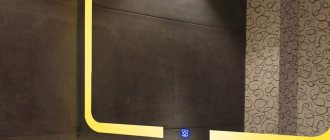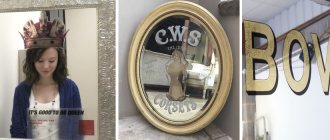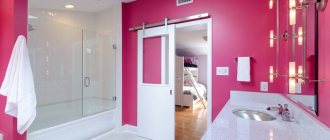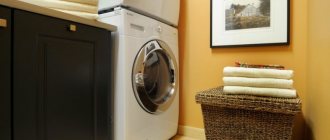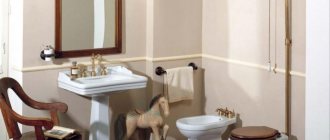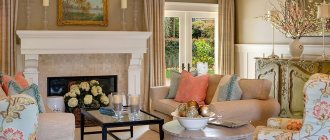Home » Decor » Wallpaper
BathroomDesignWallpaperWall Decoration
Alyona
The bathroom is a room with its own microclimate, high humidity, and serious temperature changes. Therefore, when thinking about bathroom design, preference is often given to ceramic tiles, porcelain stoneware, and plastic panels. But specialized stores offer wallpaper for bathrooms that are not inferior to tiles in terms of basic performance and technical indicators. Everything is discussed in more detail later in the article.
Liquid wallpaper is the best alternative to tiles
For rooms with high humidity, liquid wallpaper is an original and justified solution. They are characterized by moisture resistance, the ability to absorb water vapor and high cleaning performance. If one of the sections is damaged during operation, it can be updated in 10-20 minutes.
Wallpaper in the bathroom looks beautiful
This is a high-quality finishing material for anyone who is interested in decorating their bathroom in an interesting way, showing creativity and out-of-the-box thinking, without using standard cladding. Liquid wallpaper can be described by two epithets - originality and exclusivity.
To realize your design ideas, you need to buy the powder at a hardware store and dilute it according to the instructions before use. You can use different colors, so you can combine shades (in much the same way as when using watercolors).
It’s just great if you know how to draw - with the help of liquid wallpaper and colors you can create full-fledged drawings and paintings on the walls of the room. The material is a suitable type of finishing for the realization of creative talent.
Liquid wallpaper is the best alternative to tiles
Decorative use options
An important advantage of the material is the variety of decor options offered in stores. When using standard wallpaper, there is only one option - stick on what you bought. With liquid material, the variations are limitless. You need to determine the main color or several shades, and also decide how to apply the new finishing material.
The most popular design solutions are:
- Simple and cheerful: we use only one shade to decorate the bathroom. The option is interesting because in cases where you get tired of the color, you can add bright colors in a few hours of work using a new mixture, mosaic, or stickers.
- Universal: we buy one dry composition, create a finishing material with different shades using colors. As a result, the bathroom interior takes on an original look. Wide scope for imagination - do what you want!
An important advantage of the material is the variety of decor options
- Various: liquid wallpaper can be applied in various ways. We take a roller or any other suitable tool and smear the finishing material on the wall with stripes, ornaments, patterns - as you please! To form a complex pattern, it is recommended to first draw the outlines of future figures on the walls, and then paint over them with the composition. If you can’t make clear contours, it’s okay, because before it dries completely, the finish can be washed off with water, correcting all the inaccuracies.
- Unusual: you can use relief and structural rollers to create a unique decor or stucco effect using liquid wallpaper. To do this, you need to apply two layers: thin and thick (with a relief roller).
What kind of wallpaper can be glued in the bathroom?
Moisture-resistant wallpaper for the bathroom must meet the most important indicator that you should pay attention to: low hygroscopicity (the ability of the material not to absorb moisture). Those on which the manufacturer gives one of the markings depicting waves from one to three can be considered moisture resistant, where the more waves, the higher the moisture resistance.
Washable wallpaper for the bathroom is one of the economical options for wall decoration. They are protected by an outer special layer that prevents moisture from penetrating into the remaining layers. They do not swell or delaminate, are resistant to changes in humidity, washing with a damp sponge and removing dirt from the surface.
Liquid wallpaper in the bathroom is applied like plaster, which is based on fabric fibers, glitter and an adhesive mixture. Since liquid wallpaper has a water-based base, after hardening on the wall it needs to be coated with acrylic varnish (this will preserve the wallpaper and provide protection from moisture). They are interesting due to the variety of the final result and the ability to mix different textures. The resulting result will be unique.
Vinyl wallpaper for the bathroom is a common type when choosing a finishing material. The top layer consists of a polymer that protects deep layers from steam and temperature changes, and also withstands contact with water, which does not affect the service life and decorative features.
Their disadvantage is their high cost, which is justified by the expected quality. By using special glue, the level of fixation can be increased. For the bathroom, it is better to choose vinyl ones with a non-woven base, which have an additional opaque layer.
Self-adhesive wallpaper for the bathroom is made of a film that repels water and does not absorb moisture. They already have a layer of glue applied on them, so there is no need to purchase additional adhesive mixture.
In the photo, the wall is decorated with self-adhesive wallpaper to resemble the texture of natural stone. They consist of film and are not afraid of moisture, which is important for the bathroom.
Fiberglass wallpaper consists of fiberglass and is impregnated with starch. They do not absorb moisture, are durable, environmentally friendly, and can be repainted up to 25 times with latex paint, which is a special advantage.
Photo wallpapers will decorate the bathroom wall, provided that they are not located near the shower and are made of durable material (they should not be afraid of moisture). It is best to choose a water theme: river, aquarium, beach, ships, seabed).
In the photo, the sink is protected by a glossy monochromatic mosaic, and the free wall imitates tree trunks. The design of photo wallpaper can be varied, the main thing is that it matches the concept of the bathroom.
Manufacturers of liquid wallpaper
The bathroom is a specific room, so finishing materials for it need to be chosen wisely. The world market leader in the production of liquid wallpaper is Senideco. The company manufactures products that comply with international standards and norms.
You can use different colors
If you want to add a “zest” to the interior, then you should pay attention to the French manufacturer Cotex. The company produces a finishing coating in which you can add glitter and various grain inclusions, which gives the finish texture. In some cases, Swarovski crystals are added to the solution.
The leading Russian manufacturer is. The company's products are inexpensive, high quality (different colors can be combined well with them). Optimal for bathrooms in country houses, country houses, cottages.
Advice When choosing a material, if finances allow, there is no need to buy the cheapest and simplest liquid wallpaper (especially if the bathroom uses high-quality plumbing fixtures and beautiful decor). Low-quality compounds will not last long (usually they last only a few years). They may also contain harmful substances.
We pay attention to the quality of the material
Regardless of the manufacturer, country of manufacture, or cost of the product, you should study the packaging before purchasing. You should look through it, finding the line that the finishing material used is suitable for use in rooms with high humidity.
Wallpaper and tiles
Decorating a bathroom with wallpaper and tiles is a smart solution that allows you to create an interesting, original interior. The solution is especially relevant if the room is not small (in small apartments, a variety of finishes will look ugly and colorful).
The following types of wallpaper are optimal for use in rooms with high humidity:
- vinyl;
- liquid;
- glass wallpaper;
- all types washable (eg metal coated, acrylic).
Product print with birds
Tiles and wallpaper - optimally dividing the bathroom into separate zones. For example, you can tile those areas that will get wet the most (floor, walls near the shower, bathtub, sink). It is recommended to paste wallpaper where the towel dryer, entrance to the room, toilet cabinets, towel rack, and washing machine are located.
Tip Don't forget about the color combination.
For example, beige tiles will look good only with black or white wallpaper or patterned canvases. It is necessary to pay attention to the junction of the two materials, because in the case of unevenness or curvature, it will be this that will catch the eye, and not the beauty of the design.
In green
Tile laying options
You can lay tiles using a variety of techniques - it all depends on your ideas, the intended design, and the size of the tile products. Popular installation options are:
- Traditional technique . Provides for laying tiles in even rows to form a single grid (regardless of the size of the products).
- With offset . Laying is done obliquely with a sideways shift with each subsequent product.
- Diagonally . In this case, installation is carried out from the corner of the wall or floor surface. A good solution to use is small square tiles.
Experts note that there are more than 40 different options for laying tiles. To create a unique, interesting design in your bathroom, it is recommended to explore different solutions. It is not recommended to combine tiles of different shades and sizes on your own (in this case, it is better to seek help from a designer).
Blue color of the product in combination with white
One solution for combining tile shades is to take black and white tiles (or products in other contrasting shades). In this case, it will be possible to easily choose wallpaper that matches the color (for example, beige canvases will be just perfect).
To create the decor of kitchens and bathrooms, traditional tiles, which are represented by small square products, are often used. Depending on the intended design and size of the room, the tiles can be small (no more than 10 cm) or larger.
Wall decoration
It is difficult to combine ceramic tiles and wallpaper in one room, as it may seem at first glance. If the bathroom is small, it is strongly not recommended to use bright finishes. If you want to do something catchy, you can paint one wall (for example, where the bathtub is) in a bright color.
A classic that never goes out of style
If one wall is bright and catchy, then the tiles and other canvases should be made in extremely calm, simple shades. This will make the room look harmonious and beautiful. For example, a bright blue or light blue finish on one wall will be perfectly combined with the bed tones of other finishing materials.
One of the most common techniques when using tiles and wallpaper in the same room is to create a vertical or horizontal line. It is formed using tiles of a different color (they should be small in size). Such a solution will allow you to decorate the interior (using a vertical line can clearly delimit the space into zones).
You can decorate and design your bathroom in an unusual way by alternating tiles in a checkerboard pattern. It is not necessary to choose black and white products - any type of tiles whose colors go well together will do. For example, these could be the following combinations: red-green, blue-orange, yellow-brown.
Combination of plain and printed wallpapers
The nuances of wallpapering a bathroom
Be sure to paste the bathroom only with waterproof glue, the purchase of which must be arranged in advance. To ensure that the use of the wallpaper is long and comfortable, the wall is treated with anti-mold, anti-fungal agents before pasting.
Even if moisture-resistant materials are used, it is not recommended to glue them near the sink and bathtub. In places where there will be direct contact with water, it is best to lay tiles or plastic panels. This combination is shown in the photo.
When using wallpaper in the bathroom, you must not forget about maintaining the overall style with the plumbing, other coatings and surfaces. Since the range of canvases is huge, there is a risk of going too far with patterns and relief. In this case, it is very important to think in advance about where and how the wallpaper will be pasted and whether it fits well into the interior.
There is no need to choose very bright or dark colors, since the bathroom is a place where a person rests and relaxes, so it is better to stick to a calm design. Contrasting wallpapers look great, for example, a horizontal combination with a dark bottom and a light top. The main rule is a complete combination, as in the photo.
As with any other modest-sized room, it is best to choose wallpaper with a small pattern for the bath so that the room does not look even smaller.
Using wallpaper of different colors and textures, you can zone a room and highlight functional areas. This solution is shown in the photo.
Be sure to think about the proper operation of ventilation in advance before repairs. It is necessary to clean the old one or, if its work is not enough, install a new forced one. This is done so that the newly pasted wallpaper dries faster, and in the future does not accumulate excess moisture inside itself.
Vinyl wallpapers
Vinyl wallpaper is used in many countries around the world to decorate bathrooms and kitchens. They are presented in the form of two-layer canvases. The stores sell canvases with different patterns and color designs:
- Solid colors (red, white, gray, blue, yellow, etc.).
- Striped.
- Multi-ton.
- With an image.
- Embossed with a pattern.
Vinyl products are used in many countries around the world
For rooms with high humidity, you should choose vinyl wallpaper labeled “kitchen vinyl” . These are special washable sheets that were created for use in kitchens and bathrooms. The models are created on the basis of rubberized vinyl, which is resistant to moisture and dirt.
Often "kitchen vinyl" is used in bathrooms instead of or in combination with ceramic tiles. The material is relatively thick (compared to other types of canvas), so it will look rough in the room. Therefore, it is recommended to diversify it with suitable decoration solutions.
Suitable for areas with high humidity
What types of vinyl wallpaper are suitable for the bathroom?
The top layer in canvases of this type can be different. It determines the appearance of the coating, sound absorption, and thickness of the material. It is customary to distinguish several types:
- Smooth . Embossed, high-strength models, easy to clean. Decorated with brick, stone and other popular materials.
- Solid . Cloths with a dense structure that are resistant to various negative influences. They also imitate well-known finishing and building materials. You can choose an option to match your existing bathroom design.
- Silk . Canvases with a beautiful texture reminiscent of silk fabric. Such vinyl wallpapers are produced using silk-screen printing technology.
- Embossed foam vinyl . The presence of a foam layer allows the canvas to “breathe”. The models have a relief, clear pattern, so they are well suited for decorating bathrooms and kitchens (especially if there are slight unevenness on the walls).
Models are created on the basis of rubberized vinyl
The idea is that for rooms with high humidity, you can choose any type of vinyl wallpaper, based only on your preferences in appearance. Such canvases combine perfectly with ceramic tiles and other finishing materials.
Printing methods
When choosing canvases, it is recommended to pay attention to the technology that was used to print the design or pattern on the material. Manufacturers use different printing methods to apply images to vinyl. Popular ones are:
- Regular printing . It is used when a single color or simple patterns need to be applied to the canvas. Such models are monochromatic and can have traditional, simple images and designs, which are represented by patterns, figures, and ornaments.
- Photo printing . Canvases on which the image is applied using photo printing have a magnificent appearance. The applied drawing has good detail, high clarity, rich and bright shades. It was popular before, but now this solution is used relatively rarely in bathrooms and kitchens.
- UV printing. Vinyl is produced with bright, clear, slightly shiny images and patterns that have a three-dimensional effect. If bright light hits the surface, the canvas shimmers. An excellent option for bathrooms and bathrooms.
- Printing using stereoscopy technology . One of the most modern and interesting printing methods, the use of which allows you to obtain a 3D effect. The picture can be single, occupying the entire wall, or panoramic. Large enterprises can custom-make models that glow in the dark (due to built-in LEDs).
Creating accents
Vinyl wallpaper is great for highlighting the main area in the bathroom. To do this, it is recommended to use fabrics that have a contrasting shade. For example, if the floor and walls are (partially) tiled with white tiles, then one option is to create an accent with red vinyl wallpaper.
Bright room design option
You can cover two walls with eye-catching and bright wallpaper, continuing the composition to the ceiling. Upon entering the room, this composition will immediately catch your eye. It must be designed taking into account the existing interior style and the implemented color scheme.
A good solution for creating an accent is a combination of vinyl photo wallpaper with wallpaper of another type. It is recommended to glue photo wallpaper all over the wall. In this case, it is necessary to ensure that the color scheme of the overall composition matches the other finishing materials used.
Washable wallpaper
Washable wallpaper was specially created for use in various rooms with high humidity. Therefore, they are a suitable solution for kitchens, bathrooms, and toilets, where the problem of high humidity is especially acute. Such canvases can be combined with plaster finishing and tiled materials.
In black and white
When combining, the main thing is to correctly combine the shades and textures of various finishing materials. For example, if you choose embossed voluminous washable wallpaper, then the tiles should match. Color combinations are just as important, no matter what types of finishes are combined.
In the case of using washable wallpaper in bathrooms, experts give the following recommendations:
- The canvases must be combined with the overall style. A good example option is a combination of blue and green shades, which in the bathroom can create the effect of purity and harmony.
- If the room is small in size, then it is recommended to avoid using canvases in blue, red, and black shades.
- Bed and flesh tones will be a good solution when implementing a classic style in the interior of a bathroom. When choosing a Provence style, you can use washable wallpaper with a miniature floral print or vertical stripes.
- If the bathroom is medium to large in size, then the appropriate type of finishing would be canvases in orange and yellow shades. They will be able to bring more light and energy into the room.
Washable, suitable solution for kitchens, bathrooms, washrooms
When choosing washable 3D wallpaper, it is recommended to ensure that the canvas covers the entire wall. The image should not be interfered with by pipes, shelves and other plumbing and decorative elements. If the bathroom is small, then the image can be represented by a small bright picture.
Moisture-resistant wallpaper
Wallpaper with moisture-resistant properties is in demand and popular in the segment of finishing materials for kitchens and bathrooms. Such canvases are now available in various designs:
- Floral prints.
- Solid models.
- Striped.
- In a cage.
- With ethnic motives.
- With abstraction, with geometric shapes.
Wallpaper of this type is suitable for covering the entire room. But we recommend using combinations of different materials. This will allow you to create a high-quality room design, as well as extend the service life of the finish.
In light colors
It is recommended to combine two or more materials only if the area of the room is more than 5-6 square meters. For small bathrooms, you should choose simple design solutions without a combination of finishes and with a simple color scheme.
Where can I stick it?
When creating a bathroom design, it is necessary to take into account the practicality of using moisture-resistant fabrics. Several main areas can be distinguished:
- The first section is the wall surface above the bathtub, inside the shower stall, above the sink. These areas are most susceptible to direct exposure to water, so they try not to glue even moisture-resistant types of finishing materials to them.
- The second area is the surface 30-40 cm above the bathtub. It is considered suitable for the use of moisture-resistant canvases that have high strength and density.
- The third section is the area above 60-70 cm above the bathtub, sink, shower stall. These parts are considered relatively dry, so they are well suited for finishing with various types of wallpaper (but not ordinary paper).
- The fourth section is above 80 cm above the bathtub. A safe and suitable area for pasting, which can be used to combine different fabrics.
It is recommended to decorate areas in the room that are most susceptible to constant exposure to moisture with ceramic tiles and porcelain stoneware. Wallpaper should not be used in these areas.
Design ideas - combining materials
Moisture-resistant wallpaper is well suited for combination with other materials in the bathroom. With them, the combinations turn out to be harmonious, light, simple. This allows you to create an interesting and unique interior, even using inexpensive finishing materials.
A popular combination is the use of moisture-resistant wallpaper and tiles. Typically, ceramics are installed in areas that are exposed to direct water (the edge of the bathtub, near the sink, etc.). A good solution in this case is to glue the wallpaper above the tiles.
Combined with tiles
In the interior of bathrooms, tile materials are also often used to form mosaics on a separate surface or near plumbing fixtures. In this case, they try to choose wallpaper so that it matches the color and texture of the tile and does not stand out against its background.
If you want to create an environmentally friendly interior with an unusual design, then moisture-resistant wallpaper in the bathroom can be combined with stone or wood. Artificial or natural stone can be used in any texture and color scheme (it is easier to match the canvas to the stone than vice versa). If wood is used for the combination, it must be treated with moisture-proof compounds, otherwise it will quickly become unusable.
If you want to save a little on decorating your bathroom, you can use plastic panels. They also combine well with moisture-resistant wallpaper and are practical and easy to install. This is a good option for use together with photo wallpaper or single-color canvases.
Bohemian, classic style
Wallpaper with panels can be alternated or combined by zone. For example, the lower part of the room is decorated with panels, and the upper part with moisture-resistant fabrics. Plastic trim is almost always installed in areas exposed to water.
We weigh the advantages and disadvantages of wallpaper in the bathroom
The main disadvantages that prevent you from decorating a bathroom with wallpaper are well known. First of all, it is hygroscopicity - the ability of the paper base to absorb (be saturated) with water vapor, which is why over time the wallpaper begins to swell and then completely peel off. In addition, the glue itself, under the influence of temperature and moisture, loses its properties.
The advantages of wallpaper allow us to insist on considering it as an element of bathroom design
But, if you take into account all these disadvantages and choose the right materials (for example, glue - with increased adhesion and antifungal composition), then you can appreciate the undoubted advantages:
cost-effectiveness - bathroom design and wallpapering will significantly reduce renovation costs compared to laying tiles. When gluing wallpaper, the cost of finished 1 sq.m of wall covering (taking into account materials and work) will be almost an order of magnitude less than when using tiles
The bathroom area is quite small, which allows you to save on both the cost of work and the time spent on it
High-quality bathroom design using wallpaper will cost less than using tiles
ease of installation - you can do it yourself, unlike installing plastic panels or laying tiles, without involving specialists, which provides additional savings
Wallpapering is probably the most common skill
maintainability - if necessary, simply re-glue the wallpaper if some part comes off. If you are tired of the old interior, then simply update it. Carrying out such mini-repairs will not require large financial investments and great efforts.
Decorating bathroom walls with wallpaper makes it possible to experiment relatively often, at least compared to tiles
The wallpaper is easy to dismantle, but you will have to tinker with the tiles, plus - the process of dismantling the tiles is very dusty. If mold appears on the wall covering due to insufficient ventilation, it will be easy to remove the wallpaper, treat the walls with a disinfectant (anti-fungal) coating and glue new wallpaper
The very principle of working with wallpaper greatly simplifies repeated renovations in the bathroom.
decorativeness - the ability to select wallpapers of various patterns, colors and textures, while no other wall covering option can offer such a wide selection of options
Properly selected photo wallpapers will perfectly complement the interior of the bathroom
The ability to use wallpaper in the bathroom allows you to significantly expand the range of design ideas
Conclusion
Whether to wallpaper your bathroom or not is your decision. Above, we looked at the main options for using this finishing material in high-humidity environments, gave basic advice on this topic, and talked about the nuances.
In stores you can choose canvases that can complement the existing interior. For example, if you use wallpaper to create bright and catchy accents in the center of the bathroom, or near plumbing fixtures.
VIDEO: Choosing the best wallpaper for the bathroom
Wallpaper for the bathroom
New possibilities for long-familiar material
How to use wallpaper to add volume to a small bathroom
When choosing wall coverings in the bathroom, you should not experiment with an abundance of patterns and textures. This can make the space very uncomfortable, uncomfortable and narrow. The best option would be wallpaper in light, beige, brown, gray tones with a glossy texture and without a lot of patterns. The pattern on the wallpaper in the toilet should be as simple as possible. It can be stripes, diamonds and squares, peas. For a small bathroom, wallpaper with diagonal stripes is perfect to help expand the space. When planning, it is also worth taking into account the possibility of combining the colors of the wallpaper with tiles, skirting panels, doors and ceilings.
Waterproof wallpaper for the bathroom.
